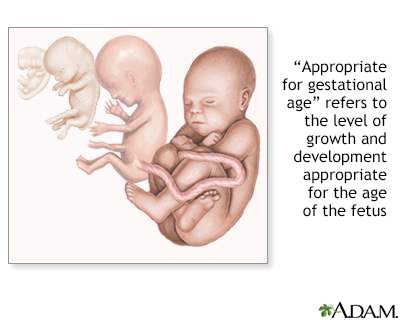Appropriate for gestational age (AGA)
Fetal age; Gestation; Development - AGA; Growth - AGA; Neonatal care - AGA; Newborn care - AGA
Gestation is the period of time between conception and birth. During this time, the baby grows and develops inside the mother's womb.
If the baby's gestational age findings after birth match the calendar age, the baby is said to be appropriate for gestational age (AGA).
AGA babies have lower rates of problems and death than babies that are small or large for their gestational age.
Images

Information
Gestational age is the common term used during pregnancy to describe how far along the pregnancy is. It is measured in weeks, from the first day of the woman's last menstrual cycle to the current date. A normal pregnancy can range from 38 to 42 weeks.
Gestational age can be determined before or after birth.
- Before birth, your health care provider will use ultrasound to measure the size of the baby's head, abdomen, and thigh bone. This provides a view on how well the baby is growing in the womb.
- After birth, gestational age can be measured by looking at the baby. Weight, length, head circumference, vital signs, reflexes, muscle tone, posture, and the status of the skin and hair are assessed.
Graphs are available showing the upper and lower normal limits for different gestational ages, from around 25 weeks of gestation through 42 weeks.
The weight for full-term infants that are born AGA will most often be between 2,500 grams (about 5.5 pounds [lbs] or 2.5 kilograms [kg]) and 4,000 grams (about 8.8 lbs or 4 kg).
- Infants weighing less are considered small for gestational age (SGA)
- Infants weighing more are considered large for gestational age (LGA)
Related Information
Gestational ageReferences
Ball JW, Dains JE, Flynn JA, Solomon BS, Stewart RW. Growth and nutrition. In: Ball JW, Dains JE, Flynn JA, Solomon BS, Stewart RW, eds. Siedel's Guide to Physical Examination. 10th ed. St Louis, MO: Elsevier; 2023:chap 8.
Nock ML, Olicker AL. Tables of normal values. In: Martin RJ, Fanaroff AA, Walsh MC, eds. Fanaroff and Martin's Neonatal-Perinatal Medicine. 11th ed. Philadelphia, PA: Elsevier; 2020:Appendix B, 2028-2066.
Richards DS. Obstetric ultrasound: imaging, dating, growth, and anomaly. In: Landon MB, Galan HL, Jauniaux ERM, et al, eds. Gabbe's Obstetrics: Normal and Problem Pregnancies. 8th ed. Philadelphia, PA: Elsevier; 2021:chap 9.
BACK TO TOPReview Date: 11/6/2023
Reviewed By: Neil K. Kaneshiro, MD, MHA, Clinical Professor of Pediatrics, University of Washington School of Medicine, Seattle, WA. Also reviewed by David C. Dugdale, MD, Medical Director, Brenda Conaway, Editorial Director, and the A.D.A.M. Editorial team.

Health Content Provider
06/01/2025
|
A.D.A.M., Inc. is accredited by URAC, for Health Content Provider (www.urac.org). URAC's accreditation program is an independent audit to verify that A.D.A.M. follows rigorous standards of quality and accountability. A.D.A.M. is among the first to achieve this important distinction for online health information and services. Learn more about A.D.A.M.'s editorial policy, editorial process and privacy policy. A.D.A.M. is also a founding member of Hi-Ethics. This site complied with the HONcode standard for trustworthy health information from 1995 to 2022, after which HON (Health On the Net, a not-for-profit organization that promoted transparent and reliable health information online) was discontinued. |
The information provided herein should not be used during any medical emergency or for the diagnosis or treatment of any medical condition. A licensed medical professional should be consulted for diagnosis and treatment of any and all medical conditions. Links to other sites are provided for information only -- they do not constitute endorsements of those other sites. © 1997- 2024 A.D.A.M., a business unit of Ebix, Inc. Any duplication or distribution of the information contained herein is strictly prohibited.
